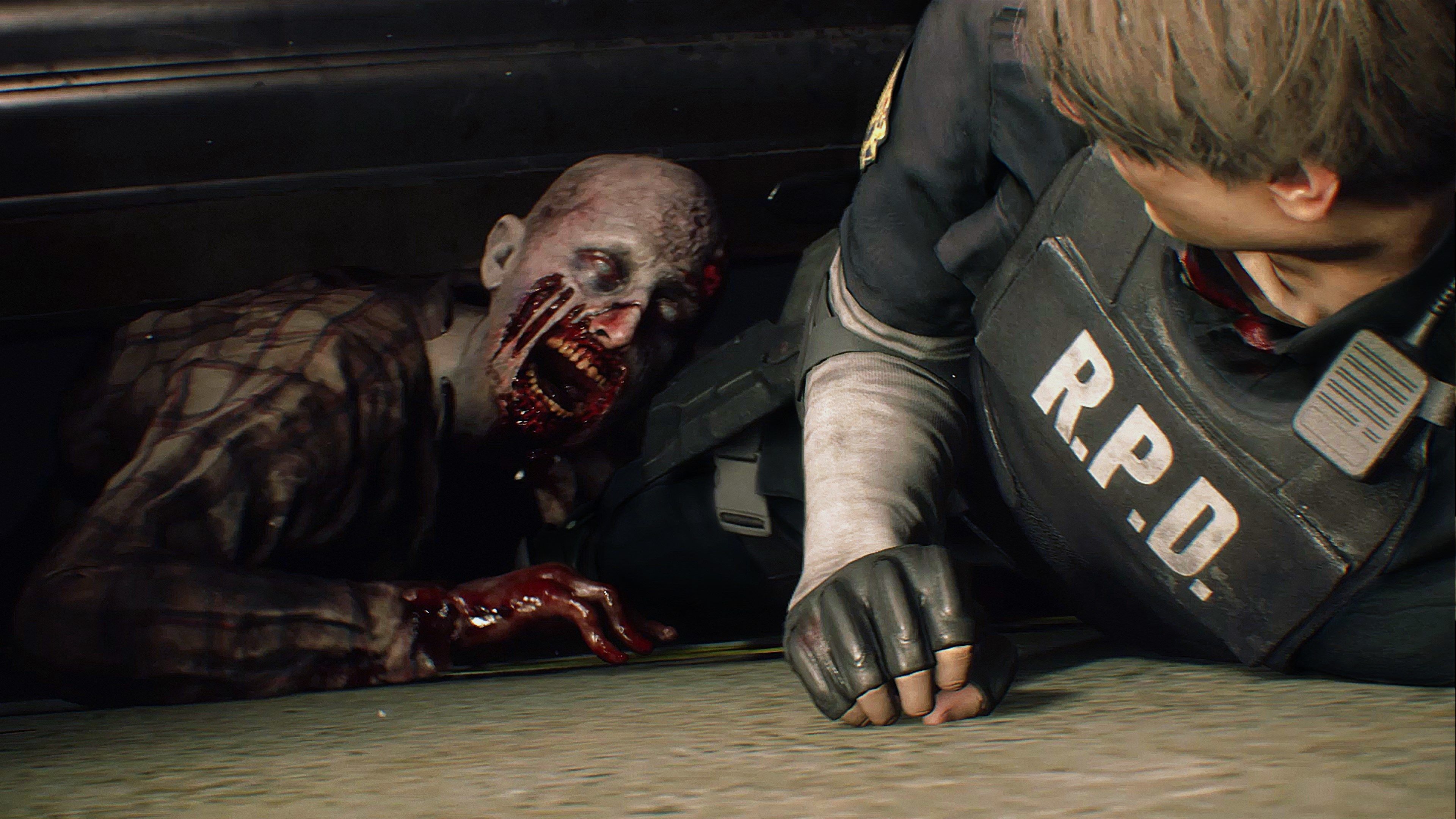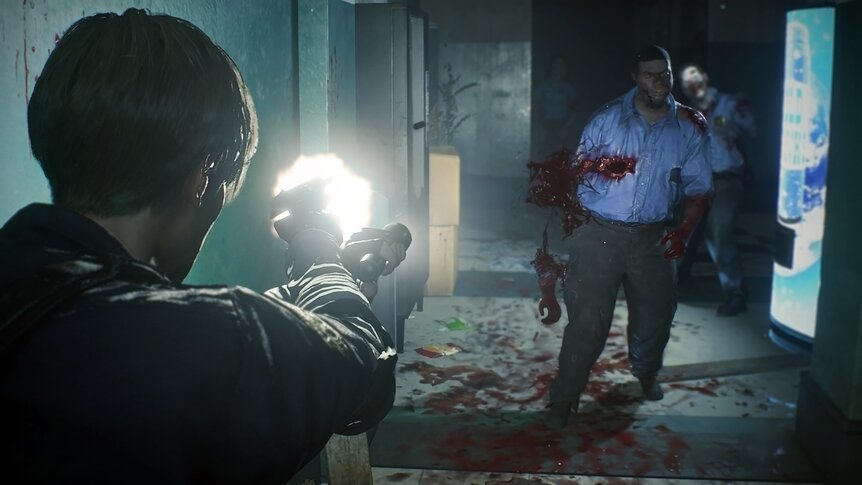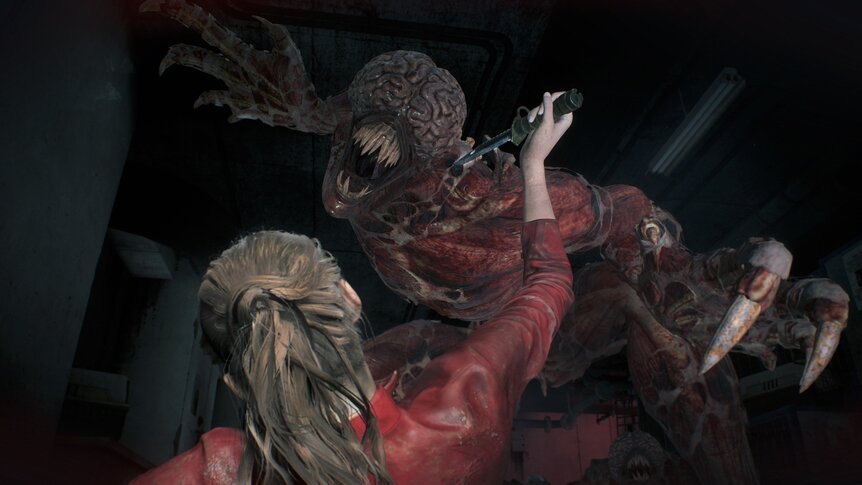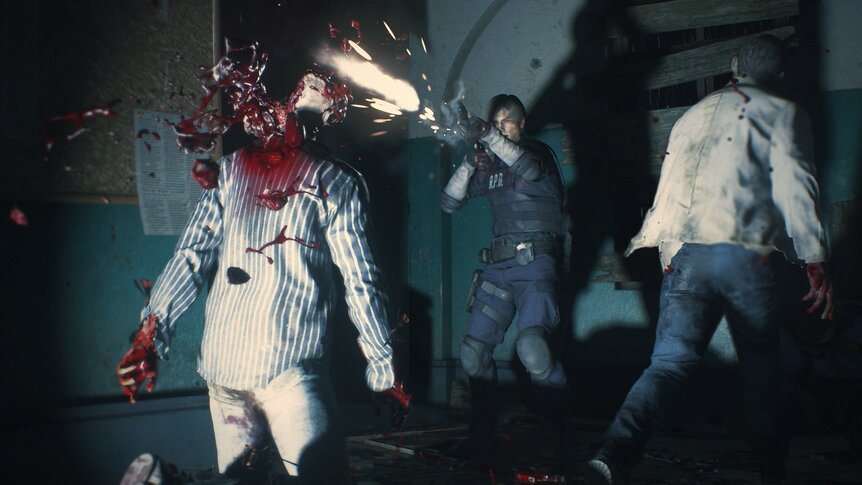Create a free profile to get unlimited access to exclusive videos, sweepstakes, and more!
Examining Resident Evil 2's gory evolution with director Kazunori Kadoi

For the past two decades, the Resident Evil franchise has been synonymous with zombie horror. A few entries may have strayed from the path, but Capcom's legendary series helped define an entire genre and has found ways to adapt to gaming's changing tides year after year. The series was so successful that Capcom re-released several Resident Evil titles multiple times. In all those years, however, Resident Evil 2 never got that revamp love, much to the chagrin of fans.
Memorable for its dueling narratives, challenging gameplay, and thrilling set pieces, Resident Evil 2 has long been a benchmark of quality in the survival horror genre. Finally, after years of fans begging for a chance to return to Raccoon City, Capcom acquiesced and announced a ground-up remake of Resident Evil 2.
Using the proprietary and powerful RE Engine, the Resident Evil 2 remake team brought back everything that made the 1998 original so great, while cranking up the terror to match the expectations of today's horror fans. SYFY WIRE spoke with Resident Evil 2's director Kazunori Kadoi to learn more about how the developers were able to modernize the survival horror standout and bring the long-awaited remake to disturbingly gory life.
Even though the first entry in the franchise went through several variations that included different tiers of censorship around the globe, 1996's Resident Evil presented a more classic take on zombie horror. Inspired by George Romero's Living Dead films, the opening entry in the fan-favorite series didn't present its gore as an in-your-face feature. Some of that had to do with the power of the PlayStation console at the time, but even later remakes featured decaying zombies that wouldn't look out of place in 1978's Dawn of the Dead. Any bloody elements were more practical than showy, allowing players to get a sense of the violence without being overwhelmed by it.
"The classic Romero zombies are like a powerful metaphor for sickness," Kadoi told SYFY WIRE. "It physically showcases that instinctual part in all of us to stay away from disease so that we don't contract it ourselves. That kind of physical portrayal of an invisible threat is what we strived to achieve in Resident Evil 2 as well."
The original game made its name not by featuring extreme levels of terrifying violence, but by cleverly pacing its combat and scares to keep players on edge. While you could blow the heads off the shambling undead creatures roaming the mansion, they exploded in a mist of red liquid that quickly disappeared; it was bloody and violent, but it wasn't scary or gross. The original engine just wasn't capable of bringing any kind of realism to Resident Evil's combat. At the time, though, it didn't matter. What transpired on screen was still something to behold for players in the mid-'90s. That presentation style worked well for the original Resident Evil 2 and its follow-up Resident Evil 3: Nemesis, but could be considered tame by today's zombie-infested standards.
Though the first Resident Evil has been revisited more than a half-dozen times, Resident Evil 2 wasn't quite so lucky. The fan-favorite sequel had a few ports to other consoles, but never got true remaster love like its predecessor. Dual protagonists Leon Kennedy and Claire Redfield even starred in their own solo games, but their shared adventure remained forever stuck in the last millennium. In 2015, Capcom finally announced concrete plans to bring Resident Evil 2 up to date.
"We knew that fans having been waiting for a remake of Resident Evil 2 for quite some time," Kadoi explains. "It wasn't a matter of ‘would' we remake it, but a matter of ‘when' we would remake it.
"20 years later, it felt like the perfect time due to two main factors: Capcom's proprietary RE Engine and Resident Evil 7," he explained. "We had the experience of working on modern hardware with RE7 and had the technology of the RE Engine to back up our vision. It gave the opportunity to incorporate that extra level of detail that we may not have been able to create in the past, in a more efficient and cost efficient manner."
Resident Evil 7 eschewed the familiarity of the over-the-shoulder camera the series had adopted for Resident Evil 4, 5, and 6, and its first-person perspective provided a tremendous showcase for what the RE Engine could do; the detail was slick and meaty, and the photorealistic presentation gave the game a very lived-in feel. The lack of zombies, which were dumped in favor of more supernatural enemies, allowed the rural Resident Evil 7 to be violent without being grotesque. By returning to the zombie-filled streets of Racoon City, though, Capcom would have an opportunity to redefine zombie horror for the first time in years.
Point of View
The new Resident Evil 2 turned back to the claustrophobic over-the-shoulder view, giving players a more intimate experience when playing as Leon or Claire. The first-person camera does have its merits, but there's more emotional investment in a character when you can actually see him or her on screen. You don't want Leon or Claire to get infected not only because that means a "game over" for you, but because you don't want them to befall the same fate as the groaning, sickening masses Umbrella unleashed on the world.
And the zombies in Resident Evil 2 do look sick, in both the strict definition of the word and the slang parlance. The RE Engine provides such an authentic look to decaying physical beings, it's often hard to look at the zombies at all, let alone after they've been shot a few times. That's not just the development team pushing the limits of the engine, but part of the thematic design of the remake's world.
"With the strength of the latest technology, it definitely was one of our goals to portray photorealistic violence in an effort to maximize the tension and feel of survival horror," Kadoi said. "However, constantly bombarding someone with scares can be a bit much. Too much of it can desensitize someone and lower the frights that await them later down the line.
"Part of making successful survival horror is keeping someone off-balance and on their toes so that they don't know what to expect around the next corner. In order to achieve this, it's about balancing and feeding the player moments of heightened terror and moments of calm."
Whereas the original Resident Evil 2 relied on camera placement and strict pacing to deliver its tension and frights, the remake lets players uncover the world as they see fit. The developers working on this iteration had to rethink how to deliver the same kind of fraught feelings without taking any of the player's agency.
That didn't mean reinventing the entire game, though. It just meant Kadoi and his team had to carefully dissect what made the 1998 game so memorable and apply those tenets to the 2019 version.
Adapting the narrative
From a story standpoint, that challenge meant adapting the four different narratives from 1998 into a more streamlined tale that hit all the right notes without echoing them exactly. From a design perspective, Capcom knew it had to take things to new levels with the RE Engine. Resident Evils 4, 5, and 6 all had their quirks, but like the first three core games, they didn't rely on the horrors of the human body. The foes in those three games were infected with a different kind of virus and strayed far from the series' traditional, Romero-style undead. Shooting these creatures was a means of progression, not a means of survival like it was in earlier games.
With the return to Resident Evil 2 came a return to those familiar walking corpses, and with the RE Engine, all the freakish detail Capcom could offer. Ahead of the game's release, the "wet gore" of this revision was hyped as a key factor in Resident Evil 2's foundation. It's impressively horrific and is undeniably tough to look at when the camera pulls in tight. You'll never look at disemboweled intestines the same way again. What really makes this attempt at body horror stand out however is how the zombies react to being shot.
"The first thing we paid close attention to is the display and impact when the player first fires at a zombie," Kadoi says. "In order to make it truly memorable, we wanted to make the wound as realistic and visceral as possible. The ‘wet gore' visual theme we strove for plays into it where you instinctually shy away from an open wound.
"[We] spent a fair amount of time during development making sure the motions and display of wounding something carried a certain level of impact and weight. For example, we consider the shotgun one of the weapons that gives players an edge off some of the tension, since it literally gives them an explosive offensive capability. To make it that much more satisfying to wield, we made sure that when you fired at a zombie with it, you really feel the impact of the weapon."
Zombies feel it too. Where once the head of zombies turned to a burst of red on the screen when hit with a shotgun blast, they now explode with viscera, leaving hollowed husks of previous human waste in their wake. The feeling of taking down a zombie with one shot was already one of the best feelings in a Resident Evil game, but the visual sensation is so much more powerful in this remake that it's actually hard to celebrate the moment. Just a little, anyway.
That level of ridiculous detail extends to more well-known fantastical creatures, including the infamous Lickers. These monsters are all exposed muscle and sinew, with their brains out in the open for anyone to see. Lickers in the original RE2 didn't quite live up to the concept art. In 2019 though, they're downright nasty. That same level of attention to detail was paid to every monster, from the zombie Dobermans to Mr. X, but the Lickers stand out.
Kadoi merely views it as his team bringing the most authentic version of Resident Evil 2's monsters to life.
"I wouldn't necessarily equate what we've done as ‘improving' upon the original, but more accurately portraying what the original development team had imagined at the time," Kadoi says. "On top of that, it's a title from over two decades ago and the memories of it have definitely changed and evolved in fan's minds as well. Making sure we created a title that would capture and accurately portray the nostalgia of our fans was a key component during the design phase."
Ultimately, everything done on the new Resident Evil 2 was created with honoring the fans and the classic version in mind. From the slippery new violence to the revamped approach to how tension and anxiety are built, Kadoi's focus was on crafting the best possible version of Resident Evil 2 he and his team could deliver with the RE Engine.
"We wanted to make sure that with whatever we did, we paid absolute respect to the original," Kadoi says. "It was a delicate balance of figuring out what to keep consistent from the original and what to update for modern hardware. We also knew there would be a heightened expectation from longtime fans that have waited for a remake of the title. We wanted to make sure that not only would they be satisfied in jumping back into the world of Resident Evil 2 with heightened graphics, but that there would be twists and turns that would keep it fresh, new, and exciting as well."





























